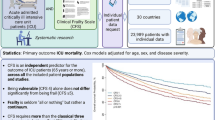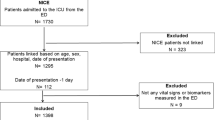Abstract
Objective: To develop a simple and comparable clinical method able to distinguish between higher and lower complexities of care in the ICU. Design: Retrospective analysis. Setting: Database of European ICUs Study I (Euricus-I: including 12,615 patients and 55,464 patient/days), prospectively collected in 89 ICUs of 12 European countries. Methods and results: A panel of experts developed the classification of the complexity of care. Six (in addition to monitoring, two levels of respiratory support – R and r – two levels of circulatory support – C and c – and dialysis) out of the nine items of Nine Equivalents of Nursing Manpower use Score (NEMS), a therapeutic index, were utilised. Two levels of care (LOCs) were defined according to a more (HT) and a less complex (LT) combination of common activities of care. The two LOCs were significantly related to mortality: higher in HT and they rose with increasing cumulative number of HT days. HT accounted for 31,976 NEMS days (57.7%) while 23,488 (42.3%) were LT. Major respiratory and cardiovascular support accounted for about 80% of the HT days. Respiratory assistance and monitoring were responsible for an equivalent percentage of LT days. The distribution of the clinical classification of LOCs coincided with that of the managerial scores of LOCs in the literature. Conclusions: The managerial instrument described uses simple and reliable clinical data. It is able to distinguish between patients with different severity and outcome, and shows that every additional consecutive day spent in ICU as HT increases the probability of death. Moreover, (1) it suggests the possibility of describing the clinical course of illness by relating the complexity/level of medical care to the available technology and staff; (2) using relevant markers of clinical activity, it might be useful to include in quality control programmes.
Similar content being viewed by others
Author information
Authors and Affiliations
Additional information
Final revision received: 11 September 2000
Electronic Publication
Rights and permissions
About this article
Cite this article
Iapichino, G., Radrizzani, D., Bertolini, G. et al. Daily classification of the level of care. A method to describe clinical course of illness, use of resources and quality of intensive care assistance. Intensive Care Med 27, 131–136 (2001). https://doi.org/10.1007/s001340000776
Received:
Accepted:
Published:
Issue Date:
DOI: https://doi.org/10.1007/s001340000776




